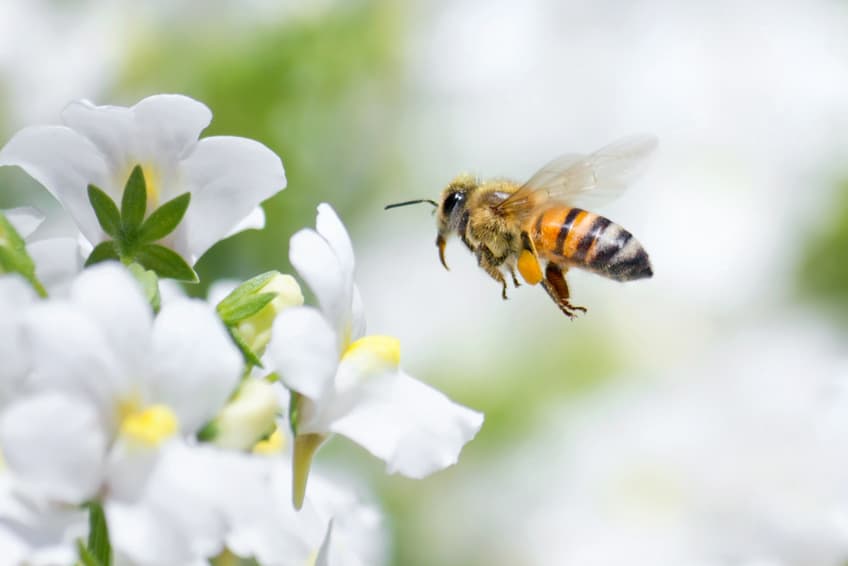You might not extend hospitality to bees who make their hives on your deck or who fly around your family barbecue. But the truth is that we need these buzzing insects. Honey bees are in serious trouble — and that means that humans could be, too. The reasons behind their population decline are numerous, but so are the ways in which the average home gardener can help.
For the last decade or so, the honey bee population has experienced what’s known as Colony Collapse Disorder (or CCD). This widespread phenomenon involved the total disappearance of adult worker bees. Even stranger, bees from neighboring hives and other insects did not try to raid the hives that were affected. Since then, beekeepers are still reporting extremely high colony losses — sometimes as much as 45%. A “normal” colony loss for beekeepers used to be around 17% per year. And because pollinators like honey bees are responsible for the majority of the crops we grow and eat in the United States, those numbers are extremely troubling.
The exact causes of CCD are not definitively known, but scientists believe that a combination of parasitic mites, habitat loss, pesticides, and climate change have had a disastrous impact on the humble honey bee. And although the typical home gardener can’t expect to make a scientific discovery that could restore the worldwide population of honey bees, they can make some simple changes to promote population growth on a local level.
Choose Your Plants Carefully
Around 51% of homeowners who upgrade their outdoor spaces spend six or more hours there per week, with gardening being one of the top three activities performed there. But if you’re inclined to dig in the dirt and plant some flowers for your pollinating friends, you need to be a bit discerning. Some people assume that because a plant has flowers, it’s attractive to bees. But keep in mind that flowers are a bee’s source of food — and some flowers are a better food source than others.
As a general rule, native plants and wildflowers are among the best flora you can add to your garden. You can make it easy for bees to get to their food source at any time by opting for colorful plants that bloom throughout the season. Butterfly bush, lupine, zinnia, lavender, aster, delphinium, coneflower, butterfly weed, sunflowers, yarrow, hyssop, mint, black-eyed Susan, aster, hyacinth, lilac, calendula, echinacea, bee balm, hosta, snapdragons, foxglove, sedum, witch hazel, and goldenrod are all excellent choices for bee-friendly flowers. You should consider skipping flowers with double flower tops and any hybrid varieties that aren’t bred to seed. Finally, consider leaving dandelion and clover alone; you may not think it represents a healthy lawn, but the bees will definitely be happy!
Stop Using Harmful Chemicals
Speaking of lawn maintenance: don’t be too quick to use herbicides. Recent studies have highlighted the hazards associated with weedkillers like RoundUp. In fact, this chemical has been found in honey supplies. That means that its use is killing the bees and could be potentially harmful to humans who consume that honey.
But it’s not just herbicides that can harm the bee population. Pesticides do, too. Flying pests can admittedly make spending time outdoors a real pain. After all, no one likes to be bitten or stung. The U.S. pest control industry grew by 2.9% between 2012 and 2017, but that’s not actually all good news. The toxic chemicals used by pest control companies and even commercial products to reduce irritating insect activity has had a horrible effect on bees. And despite the fact that the current presidential administration recently lifted an established ban on the use of pesticides, environmentalists say that their reinstated use could be highly dangerous to this already vulnerable population. Unfortunately, so-called “bee friendly” pesticides aren’t actually any better. A new study found that these alternatives may have damaging effects on colony health.
However, there are some natural, homemade options that won’t harm our buzzing buddies. Neem oil, apple cider vinegar or white wine vinegar, Epsom salt, pepper sprays, certain types of soap, aluminum foil, essential oils, and even chrysanthemums can keep unwanted pests away without hurting honey bees.
Offer Water and Shelter
Helping out the bees isn’t actually all about flowers. You may need to go a little further to make sure your yard is a welcoming environment. In some ways, bees are just like us; they need a little shelter and some water to survive.
Bees will feed on the pollen and nectar, but they require water as well. You can give them a place to take a sip and sit for a spell by filling a bird bath, rain catcher, or other shallow container with water (along with some rocks or sticks). And if they need a place to rest or take shelter from a storm, you can provide that with some carefully placed pots, a wilder patch of yard, or even bee houses that are cropping up at local garden stores. Don’t be afraid to devote a small area of your yard to helping bees.
It may not look as picture-perfect as you envisioned, but your efforts can go a long way. Although spending 5% of the value of your home on landscaping could increase your property’s resale value by 15%, there are actually wrong ways to landscape — at least where the bees are concerned. Experts explain that the “cookie cutter” landscaping approach can actually keep bees from buzzing around. By abandoning boring landscaping for something a bit more wild and natural, you could help pollinators thrive.
You don’t necessarily have to be a highly skilled gardener to assist pollinators on your property. But by choosing the right plants, ditching harmful chemicals, and being more thoughtful about what you include in your yard, you’ll know that you’re allowing local bee populations to do their thing, honey. And that’s pretty sweet, right?



